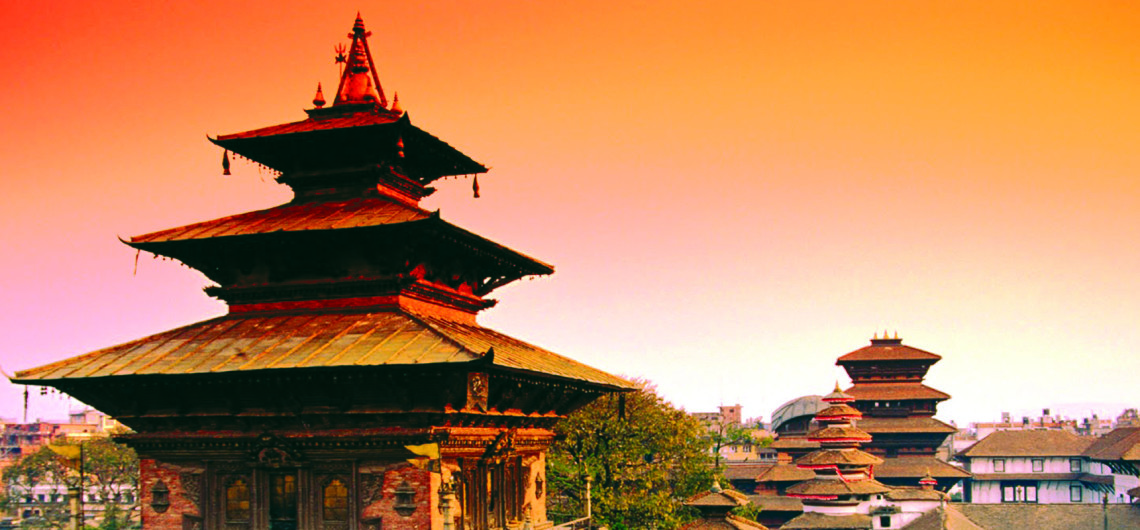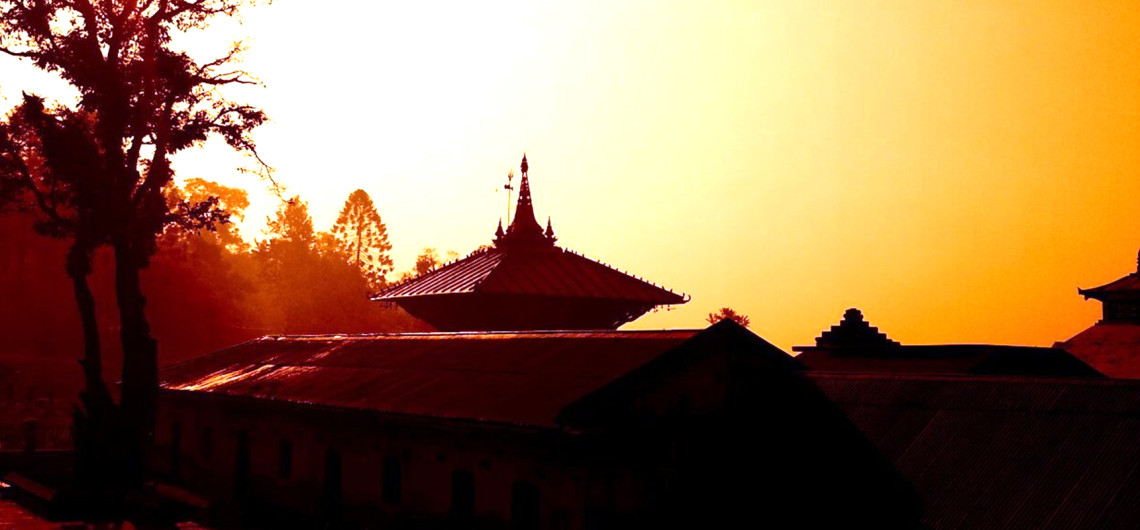There are many historical, cultural and peaceful places to visit at Kathmandu and some of them are as follows:
Kathmandu Durbar Square:
It is the historic seat of royalty. The Durbar square, with its old temples and places, epitomizes the religious and cultural life of people. It is here that kings of Nepal are crowned and their coronations solemnized. Interesting things to see here are Taleju Temple built by Mahendra Malla in 1549 AD, the temple of Kaal Bhairav (God of destruction), Nautalle Durbar, Coronation Nasal Chowk, Gaddi Baithak, Statue of King Pratap Malla, Big Drum, Jagannath Temple and Kasthmandap. It was listed in the UNESCO World Heritage Monument list in 1979 AD.
Goddess Kumari (the only living goddess in the world): Kumari (Vestal Virgin) or the only living Goddess in the world, who represents a very ancient Hindu deity of Nepal locally known as Taleju. The temple Kumari is situated in the vicinity of Hanuman Dhoka Palace. The building has intricately carved wooden balconies and window screens. The Kumari acknowledges greetings from her balcony window.
Kasthamandap:
Located near the temple of Kumari, it is said to have been built by King Laxmi Narsingha Malla in the beginning of the sixteenth century. It is said to be constructed from the wood of a single tree. The city of Kathmandu derives its name from this temple.
Ashok Vinayak:
The small but a very important temple of Ashok Vinayak is situated behind the Kasthamandap -also known as Kathmandu Ganesh or Maru Ganesh.
Jaishi Dewa:
Five minutes from Kasthmandap the Shiva Temple of Jaishi Dewal is famous for its erotic carvings. It is still one of the main routes of the chariot festival of Indra Jatra, Gai Jatra and other festivals.
Tudikhel:
A huge green field, flanks one entire side of the old city Tudikhel. Some of the important landmarks of Kathmandu valley are located in the periphery of this area. At the south western end of Tudikhel is a 59.29m. Tower built by Prime Minister Bhimsen Thapa in 1832 A.D. known as Dharahara (or Bhimsen Stambha). Sundhara-fountains with golden waterspouts is situated at the foot of this great tower also belonging to the same period.
Pashupati Nath Temple:
Situated 5 km. east of Kathmandu, the temple of Lord Shiva, Pashupati Nath, with tow tiered golden roof and silver door is considered one of the holiest shrines for Hindus, although only Hindus are allowed inside temple, visitors can clearly see the temple and the activities performed in the temple premises from the eastern bank of the Bagmati river. The temple was listed in the UNESCO World Heritage Monument list in 1979 AD.
Guheswari Temple:
Near Pashupatinath is located another historic and holy temple of Guheswari. Only Hindus are allowed to enter the temple courtyard.
Boudha Nath Stupa:
The stupa lies 8 km. east of Kathmandu. This ancient colossal Stupa is one of the biggest in world, and the center of Tibetan Buddhism in the world. It was listed in the UNESCO World heritage Monument list in 1979 AD.
Swoyambhunath Temple:
A top the green hillock west of Kathmandu stand the great Stupa of Swoyambhunath – a masterpiece of bronze art, situated some 4kms. from main Kathmandu City and above 77 meter from Valley floor. On all four side of the structure are painted the ‘All seeing’ eyes of Buddha looking out on all direction at the Valley below. Between them is the mystic third eye symbolic of true wisdom. Its dazzling white hemispherical mound represents the four-element earth, fire, air and water. The thirteen gilded rings on the spire are the thirteen degrees of knowledge and represent the ladder to “Nirvana” symbolized by the umbrella at the top. Around the Stupa runs a row of prayer wheels which is turned symbolically by Buddhist devotees representing the “Cycle of life and death” The Stupa was established some 2500 years ago and is the main center for all Buddhist settled in Nepal and Tibet. The spot commands a beautiful ‘bird’s eye view’ to Kathmandu Valley. The site is listed as ‘world heritage site’ by UNESCO and is one of the other seven such sites in Kathmandu Valley
CHANGU NARAYAN Temple: Perched at the abrupt end of the ridge north of Bhaktapur, the tranquil temple complex of CHANGU NARAYAN commands a fine view of the valley in three directions. “One remembers all the wealth of carving of the rest of the valley,” wrote Percival Landon in 1928, “but when all is recalled it is probably to the shrine of Changu Narayan that one offers the palm.” Landon wasn’t wrong, and once you’ve run the gauntlet of the souvenir stalls in the little village, you’ll find a site that retains its palpably holy, ancient atmosphere – not to mention the finest collection of statues outside the National Museum.
A single, stone-paved pedestrian street stretches west from the entrance booth, where you pay a fee, along the ridgetop, towards the temple at its apex. It’s lined with souvenir stalls for much of its length, or simple shops selling soft drinks and the like.
BHUDHANILKANTHA:
A paved road leads 8km north from Kathmandu to Narayanthan, a roadside village centered on BUDHANILKANTHA, the site of a monolithic and hugely impressive sleeping Vishnu statue. A visit can be combined with a hike or mountain bike ride up to the thickly forested peak of Shivapuri, from where there are some of the finest Himalayan views anywhere in the valley. The road from Kathmandu to Budhanilkantha is busy at first, but a quieter route heads north to Tokha then cuts across east.
Dakshinkali:
Dakshinkali become the one of top 10 places to visit around Kathmandu Nepal. Although Dakshinkali lies in the Kathmandu valley, but it is far from the center location of Kathmandu city. Dakshinkali is a very famous Hindus goddess Kali temple. It is situated 22km south of Kathmandu city. Entire route to the temple is a beautiful countryside drive. Regular religious worship is performed daily. A large number of animals are scarified on twice a week, on every Tuesday and Saturday. More incredible animal rituals are held during Dashain festival. On the return journey one can visit the temple of Shesh Narayan, a cave temple where Guru Padmasambhava is said to have gained his physical power through meditation. Dakshinkali is one of the best places to visit near Kathmandu Nepal.
Khokana:
Khokana is another one of top 10 Places to Visit around Kathmandu Nepal. About twenty minutes’ walk towards Karya Binayak from Bungamati, is the village of Khokana. Khokana is the famous for manufacturing mustard oil. It is worthwhile to seek out one of the village’s oil press, located in poorly lighted factories with medieval atmosphere. Khokana is one of the best places to visit near Kathmandu Nepal.
Panauti:
Panauti is another one of top 10 places to visit around Kathmandu Nepal. One of the finest Newar settlements in the region is the village of Panauti. It is built at the confluence of two rivers in a small valley surrounded by examples of early temple architecture. Among all, the most interesting ones are the 14th century Indreshwar Mahadev temple and Brahamayani temples are very good examples of historical Newari architect. The roof struts, showing different manifestations of Shiva, are matchless in their serenity. Panauti is one of the best places to visit near Kathmandu Nepal.
Dhulikhel:
Dhulikhel is another one of top places to visit around Kathmandu Nepal. A scenic 30 km drive along the terraced paddy rice field on the Arniko Highway leads to Dhulikhel, at an altitude of 1600 m. This place is famous for its vantage location for viewing the Himalayan range from Cho-yu in the east to Himalchuli in the west. Dhulikhel is very popular for viewing sunrise and sunset and for serene atmosphere free from the smoke and bustle of the Kathmandu city. It is better to stay overnight in one of the beautiful lodges to enjoy sunset and sunrise the next day. Dhulikhel is one of the best places to visit near Kathmandu Nepal.
Kakani:
Kakani is another one of top 10 places to visit around Kathmandu Nepal. One and half hours (29km) drive from Kathmandu along the beautiful mountain highway on the Trishuli road is scenically rewarding with green forest and mountain terraced cultivation. The vantage point at an altitude of 1982 m. above the sea level is famous for the magnificent view of Ganesh Himal on one side and Kathmandu city on the other side. Other peaks that can be closely seen from Kakani are Gauri Shankar, Choba Bhamare, Manaslu, Himalchuli, Annapurna and many more. Kakani is one of the best places to visit near Kathmandu Nepal.
Namobuddha:
Namobuddha is another one of top 10 places to visit around Kathmandu Nepal. There are many religious places and viewpoints around the Kathmandu Valery. One of them is Namobuddha. This is a one hour drive or 3 hours trekking from Panauti or from Dhulikhel. Very much respected place by Buddhist for its religious importance also offers beautiful countryside and commanding view of the surrounding mountain. There is a Stupa with all seeing eyes of the Buddha, Buddhist Monastery with colorful flags fluttering in the wind, a massive statue of Buddha and many more Stupas. Namobuddha is one of the best places to visit near Kathmandu Nepal.


